Abstract
Liangshan Black pigs are a new Chinese indigenous breed discovered during the Third National Survey of Livestock and Plant Genetic Resources. To uncover genetic diversity, population structure, and potential exotic introgression in this breed, we sampled 191 Liangshan Black pigs from the conservation population and genotyped these individuals using the “Zhongxin-I” porcine chip, then conducted in-depth population genetic analyses in the context of pigs from five introduced breeds. The results revealed that the tested individuals exhibited significant genetic diversity, displayed uneven kinship relationships, and were assigned to nine families according to their clustering patterns in the phylogenetic tree. Further relationship analyses with the five introduced breeds demonstrated that Liangshan Black pigs were clustered separately from the introduced breeds, had larger evolutionary distances with the introduced breeds, and possessed certain genetic components of the introduced breeds, especially those of Duroc. These findings demonstrate that Liangshan Black pigs are generally an indigenous breed independent of the introduced breeds but are slightly affected by the introduced breeds. In summary, the results of our study not only contribute to an in-depth understanding of the population genetic characteristics of Liangshan Black pigs but also provide the necessary data for the implementation of conservation programs.
1. Introduction
Historically, numerous indigenous pig breeds have been developed. They are an important component of biodiversity and also a strategic resource for guaranteeing the effective supply of animal products [1]. Given the increase of threats such as climate change, urbanization, and infectious diseases, the quantity and distribution of pig local genetic resources are constantly changing [2,3]. To get a full picture of varieties, numbers, distributions, and traits of the country’s agricultural germplasm resources, in March 2021, China launched the Third National Survey of Livestock and Plant Genetic Resources, which is the largest survey of China’s agricultural germplasm resources (https://www.chinadaily.com.cn, accessed on 24 November 2021). In this survey, some new livestock and poultry genetic resources were discovered, and Liangshan Black pigs were one of them.
Liangshan Black pigs have been selectively bred by local people over generations. They are mainly distributed in Jining city, Shandong province, which is one of the major pig-producing regions in China [4]. Besides Liangshan Black pigs, there are seven other indigenous pig breeds in Shandong: namely, Laiwu pigs, Dapulian pigs, Yantai Black pigs, Licha Black pigs, Yimeng Black pigs, Wulian Black pigs and Zaozhuang Heigai pigs according to the “National Catalogue of Livestock and Poultry Genetic Resources” (http://www.moa.gov.cn/govpublic//nybzzj1/202101/t20210114_6359937.htm?keywords) released in 2021. Similar to other indigenous breeds in Shandong, Liangshan Black pigs are highly adapted to local environments and exhibit prominent characteristics, such as robust disease resistance, strong roughage tolerance, and good pork quality [5,6]. Its conservation is of great significance for protecting the unique livestock biodiversity in the region and promoting niche markets for high-value products.
In local pig conservation farms, the core groups are composed of pigs collected from different farmers, and their pedigree information is either incomplete or even incorrect [7]. Incomplete or incorrect pedigree information will not only lead to an overly rapid increase in the inbreeding coefficient of the population and a decrease in the accuracy of genetic evaluation based on it, but it will also affect the reliability of other research relying on pedigree information, such as gene mapping and genomic selection [8,9]. Single nucleotide polymorphisms (SNPs) are characterized by high genomic coverage, wide distribution, high genotyping accuracy, and low cost and have gradually become the most commonly used molecular marker in genetic research [10,11]. In recent years, with the rapid development of molecular biology, a variety of commercial porcine SNP chips have been successively launched [12,13,14], enabling the study of the genetic diversity and population structure of pig resources at the whole-genome level [12,15].
As a newly discovered local genetic resource, the conservation status of Liangshan Black pigs, such as their genetic diversity, potential inbreeding depression risk, and family structure remain unknown. In this study, the core population of Liangshan Black pigs was genotyped using genome-wide SNP chips, and their genetic diversity, inbreeding coefficient, and intra-population relationships were systematically analyzed. Moreover, combined with the genomic SNP data of the introduced lean-type pig breeds, the influence of the introduced breeds on the Liangshan Black pigs was investigated. This study aims to generate integrative scientific evidence, thereby providing a robust foundation for developing an evidence-based, adaptive conservation framework that ensures the long-term viability and sustainable utilization of Liangshan Black pigs.
2. Materials and Methods
2.1. Experimental Animals and Sample Collection
A total of 191 Liangshan Black pigs was collected from the Provincial Nucleus Conservation Farm of Liangshan Black pigs in Jining, Shandong. Specifically, the samples encompassed all 48 boars on the farm and 143 sows randomly selected across the farm. Samples of five introduced breeds—namely, Yorkshire, Landrace, Duroc, Berkshire, and Pietrain, with 20–30 individuals per breed—were collected from their National Core Breeding Farms in Shandong province. Ear tissues were sampled and placed into 2 mL centrifuge tubes containing 75% ethanol.
2.2. Genomic SNP Genotyping and Quality Control
Genomic DNA was extracted from all samples using the Tissue Genomic DNA Extraction Kit (Tiangen Biotech, Beijing, China). The quality and concentration of genomic DNA were assessed via agarose gel electrophoresis and NanoDrop™ 2000 (Thermo Fisher, Waltham, MA, USA) to meet the requirements that the electrophoresis bands should be clear, the A260/A280 ratio should be in the range of 1.7–2.1, and the concentration should be greater than 50 ng/μL.
All individuals were genotyped using the “Zhongxin-I” Porcine Chip (Beijing Compass Agricultural Technology Co., Ltd., Beijing, China) following the manufacturer’s protocol. Subsequently, the genotype data were subjected to quality control by PLINK software (v1.90) [16] to remove the unreliable genotypes. The criteria were as follows: (i) Exclude SNP loci located on unmapped chromosomes and the Y chromosome; (ii) Remove individuals with a detection rate less than 90%; (iii) Remove SNP loci with a call rate less than 0.95; (iv) Remove SNP loci with a minor allele frequency (MAF) less than 0.05.
2.3. Analysis of Genetic Diversity and Coefficient of Relationship
Genetic diversity parameters, including MAF, observed heterozygosity (HO), expected heterozygosity (HE), polymorphic information content (PIC), identity-by-state (IBS) distance, and proportion of identity-by-descent (IBD), were evaluated for each SNP using PLINK v1.90 [16]. Another parameter, allele richness, was calculated using R package diveRsity (v1.9.89).
2.4. Analysis of Genomic Inbreeding Coefficient
Runs of homozygosity (ROHs) were identified in each sample using PLINK software (v1.90) [16]. The parameters were set as follows: The sliding window size of 50 SNPs, at least 5% overlapping ratio of the sliding windows, a minimum of 40 consecutive SNPs included in a ROH, a minimum density of one SNP in 1000 kb, a maximum interval between two consecutive SNPs less than 1000 kb, and a maximum of five missing genotypes and one heterozygous genotype in a ROH. Subsequently, the genomic inbreeding coefficient based on ROH (FROH) was calculated for each individual with the equation as described by McQuillan et al. [17]; that is, FROH = ∑LROH/LAUTO, where ∑LROH refers to the total length of ROH and LAUTO is the length of the autosomal genome covered by SNPs.
2.5. Population Structure Analyses
Principal component analysis (PCA) was carried out for all samples of Liangshan Black pigs and five introduced breeds using PLINK v1.90 [16]. Subsequently, the scatter plot of the first principal component (PC) and the second PC was drawn by R (v4.4.3) software to visualize the clusters formed by individuals belonging to the same population. The UPGMA phylogenetic tree was first drawn using the following parameters: Tajima–Nei model, uniform rates, homogeneous, pairwise deletion by MEGA X [18]. Then, the tree was colored and aesthetically enhanced by ITOL [19]. The evolutionary distances between breeds were computed using the same parameters as those in the phylogenetic tree by MEGA X [17]. Then, using the STRUCTURE program [20], the ancestry compositions of Liangshan Black pigs and the five introduced breeds were evaluated via the Bayesian clustering method with the assumed number of ancestries from 2 to 6. Finally, the mean evolutionary distances between the breeds studied were calculated using the same parameters as those for the UPGMA phylogenetic tree construction.
3. Results
3.1. SNP Genotyping and Quality Control
In this study, the genotyping of 191 Liangshan Black pigs was conducted using the “Zhongxin-I” Porcine Chip. A total of 57,466 SNP loci were detected, with an average detection rate of 0.993. After quality control, 43,752 SNPs remained for further analysis, and the distribution of these SNPs on the genome is presented in Figure 1 and Figure 2. It can be noted that, except for chromosome (Chr) X, the distribution of SNPs in the genome was relatively uniform (Figure 1). The average interval distance between SNPs was 61.22 kb, and the distribution across various chromosomes was relatively uniform. However, due to the large differences in the lengths of different chromosomes, the number of SNPs varied substantially among chromosomes. Among them, Chr1 possessed the largest number of SNPs, up to 4815, while Chr18 had the lowest number of SNPs, namely, 994 (Figure 2).
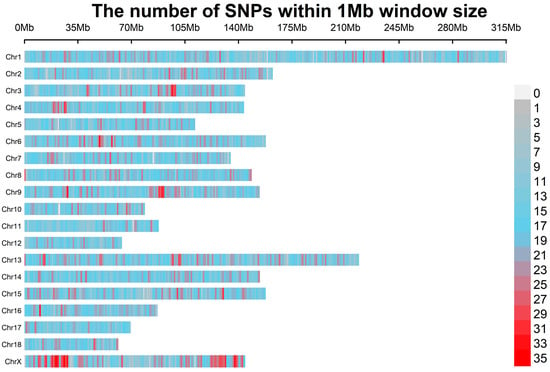
Figure 1.
The density distribution of SNPs on chromosomes after quality control.
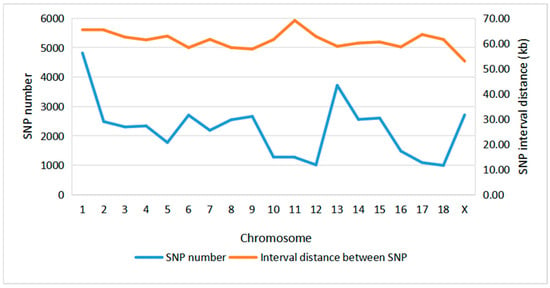
Figure 2.
The number and spacing of SNPs on each chromosome after quality control.
MAF and PIC are important indicators for measuring the capacity of genetic markers to evaluate population polymorphism. In this study, the average MAF value was 0.29. SNPs with a MAF ranging from 0.40 to 0.50 had the highest proportion (27.71%), while those with a MAF ranging from 0.05 to 0.10 had the lowest proportion (11.22%) (Figure 3A). The average PIC value was 0.30, and 63.8% of SNPs had PIC > 0.3, which were moderately polymorphic loci (Figure 3B). It can be seen that the SNP markers in this study were highly polymorphic and evenly distributed, and are thus capable of conducting genetic analysis accurately and efficiently.
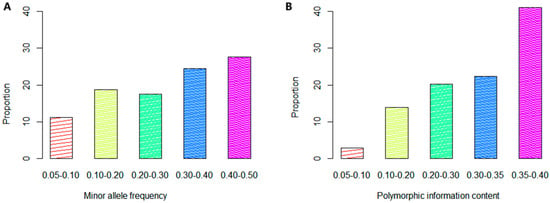
Figure 3.
The proportion of minor allele frequency (MAF) and polymorphic information content (PIC) in each interval. (A) MAF. (B) PIC.
3.2. Genetic Diversity
To evaluate the genetic diversity status of Liangshan Black pigs, genetic diversity parameters, including HO, HE, proportion of IBD, and IBS distance, were first computed based on the genome-wide SNPs remaining after quality control (Figure 4). Higher values of HO and HE, along with smaller values of the proportion of IBD and IBS distance, suggest higher genetic diversity within the population. As shown in Figure 4, the averages of HO and HE were 0.395 and 0.377, respectively, and the medians of HO and HE were 0.440 and 0.428, respectively. The averages of the proportion of IBD, IBS distance, and allele richness were 0.152, 0.713, and 1.395, respectively, and the medians of IBD and IBS distance were 0.142 and 0.712, respectively.
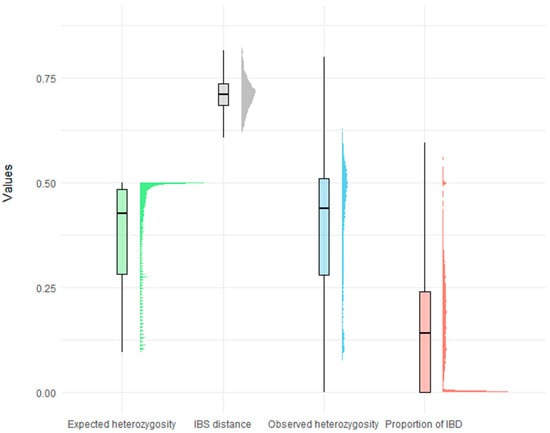
Figure 4.
Raincloud plots of genetic diversity parameters for Liangshan Black pigs.
Then, the genomic breeding coefficient was estimated based on ROH. A total of 3790 ROHs were detected in the Liangshan Black pig population, with an average of 19.83 ROHs per individual (Table 1). The average length of ROHs was 17.19 Mb, ranging from 1.85 Mb to 177.17 Mb. The average FROH was 0.1505, with the maximum and minimum values being 0.4092 and 0.0126, respectively. In combination with the standard deviation, it can be seen that the inbreeding coefficient in the Liangshan Black pig population fluctuates considerably.

Table 1.
Information on ROH and FROH in Liangshan Black pigs.
3.3. Genetic Relationships
PCA was initially carried out using SNP data to conduct a preliminary investigation on the relationships among individuals in the Liangshan Black pig population (Figure 5A). The results showed that the distribution of Liangshan Black pigs was uneven, and some individuals were relatively concentrated, suggesting relatively close relationships among them. Moreover, the kinship coefficients among Liangshan Black pig individuals were analyzed to further assess kinship status within the Liangshan Black pig population (Figure 5B). Specifically, 46.08% of individuals had a relatively distant relationship, with a kinship coefficient not exceeding 0.125; 31.33% of individuals had an intermediate kinship, with a kinship coefficient ranging from 0.125 to 0.25; 21.27% of the individuals had a relatively close relationship, with a kinship coefficient in the range of 0.25–0.50; another 1.31% of individuals had a very close relationship, with a kinship coefficient no less than 0.5.
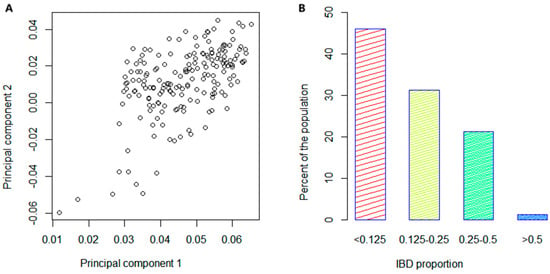
Figure 5.
Relationships among individuals in Liangshan Black pigs. (A), Scatter plot based on principal component (PC) 1 and PC2 of the Principal Component Analysis (PCA). (B), The population percentage for each interval of the IBD proportion.
3.4. Phylogenetic Analysis of Liangshan Black Pigs
To investigate the family composition of Liangshan Black pigs, the evolutionary distances between individuals were computed, and then the molecular phylogenetic tree of the core group of Liangshan Black pigs was constructed using the UPGMA method (Figure 6). The clades of the phylogenetic tree can serve as the basis for family classification. It can be observed that Liangshan Black pigs were clustered into five major clades, represented by red, blue, green, yellow, and purple, respectively (Figure 6A). Moreover, the four major clades, represented by red, blue, green, and purple, encompassed a large number of samples and had obvious sub-clades (Figure 6B). In addition, there were three small clades, each containing a relatively small number of samples, and they were not utilized as family lines. Based on the clades of the phylogenetic tree as well as the distribution of sows and boars, Liangshan Black pigs were divided into nine families.
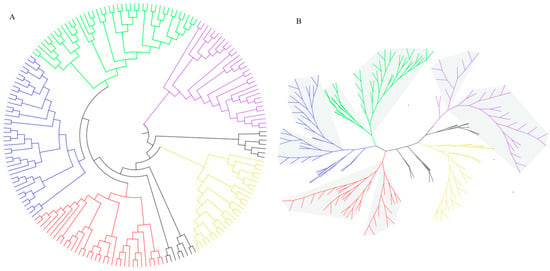
Figure 6.
Phylogenetic trees of Liangshan Black pigs. (A) The circled mode. (B) The unrooted mode. Different colors represent different major clades.
3.5. Influence of Introduced Pig Breeds on Liangshan Black Pigs
To explore the influence of introduced pig breeds on Liangshan Black pigs, PCA was initially carried out on Liangshan Black pigs and the five introduced breeds: namely, Duroc, Yorkshire, Landrace, Berkshire, and Pietrain. PC1 and PC2 accounted for 62.01% and 27.32% of the variation, respectively. A scatter plot was drawn based on the two principal components (Figure 7). It can be seen that the Liangshan Black pigs were relatively scattered in distribution, while the introduced breeds were clustered. There was no overlapping area between Liangshan Black pigs and the introduced breeds, but a small number of Liangshan Black pigs were closer to the introduced breeds, especially to Duroc.
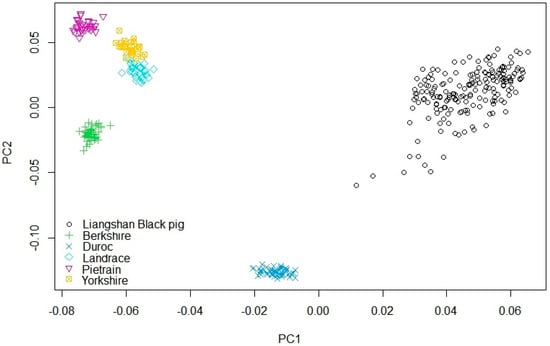
Figure 7.
Scatter plot of Liangshan Black pigs and the introduced breed pigs based on principal component (PC) 1 and PC2 of the Principal Component Analysis (PCA).
Subsequently, the ancestral lineage compositions of Liangshan Black pigs from the five introduced breeds were analyzed by STRUCTURE V2.3.4 (Figure 8). Based on prior information about the population studied, K values of 2, 3, 4, 5, and 6 were selected to determine the optimal K value. When the K value was set to 2, Liangshan Black pigs were clustered into one group (marked in red), while pigs from the five introduced breeds were clustered into the other (marked in green). As the K value increased, Duroc (K = 3), Berkshire (K = 4), and Pietrain (K = 5) were gradually clustered into separate populations. As the K value increased to 6, further differentiation took place within the Liangshan Black pigs, whereas Landrace and Yorkshire still could not be divided into two independent populations. Therefore, it was assumed that the appropriate number of ancestries was 5. It can be noted that there was Duroc introgression in Liangshan Black pigs. The result of individual ancestry inference indicated that the average proportion of the Duroc cluster in Liangshan Black pigs was 0.1015, and there were 18 individuals with a Duroc cluster proportion higher than 0.2.
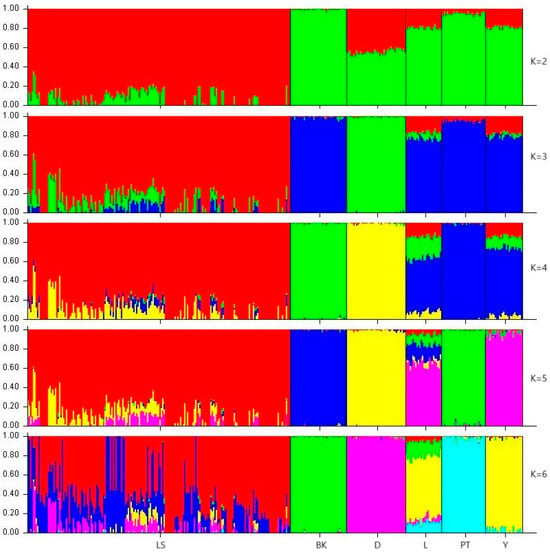
Figure 8.
The ancestry compositions of Liangshan Black pigs and five introduced breeds uncovered by STRUCTURE with the assumed number of ancestries from 2 to 6. Each color represents one ancestral cluster. LS, BK, D, L, PT, and Y are the abbreviations for Liangshan Black pigs, Berkshire, Duroc, Landrace, Pietrain, and Yorkshire, respectively.
Finally, we further computed the evolutionary distances between Liangshan Black pigs and the five introduced breeds (Table 2). The average evolutionary distance between Liangshan Black pigs and these five introduced breeds was 0.6425, which was greater than that among the five introduced breeds (0.6250). Among them, the genetic distance between Liangshan Black pigs and Pietrain was the largest, up to 0.6785, while that between Liangshan Black pigs and Duroc was the smallest, being 0.5649.

Table 2.
Mean evolutionary distance between Liangshan Black pigs and the introduced breeds.
4. Discussion
Liangshan Black pigs are a new Chinese indigenous breed discovered during the Third National Survey of Livestock and Plant Genetic Resources. Knowledge of their genetic diversity and population structure is a preliminary step in developing a sustainable conservation and utilization scheme for them. High-density SNP chips, whose markers are evenly distributed across the genome, have become the most commonly used tools in genomic data analysis. Therefore, in this study, we comprehensively analyzed the genetic diversity and population structure of Liangshan Black pigs based on genome-wide SNP data.
A total of 191 individuals covering all lineages of Liangshan Black pigs were genotyped using the “Zhongxin-I” Porcine Chip. During the designing of this chip, SNPs discovered in major commercial breeds as well as nine Chinese native breeds, such as two-end-black pigs, Sutai, Laiwu, Erhualian, and Bamaxiang, were taken into account to improve the chromosome coverage and MAF of Chinese native breeds [21]. Thus, this chip is suitable for both commercial pig breeds and Chinese local breeds. The total number of SNPs on this chip is 57,466, which is slightly fewer than those on the widely used Illumina 60K BeadChip [14] and GeneSeek Genomic Profiler Porcine HD BeadChip [13]. However, over 95% of the SNPs on this chip could be unambiguously mapped to the current pig genome (Sscrofa11.1) with an even distribution. Moreover, the SNPs on this chip possessed high MAF and PIC (Figure 3), with averages of 0.29 and 0.3, respectively. This indicates that the SNP markers in this study are highly polymorphic and are capable of accurately and efficiently conducting genetic analysis.
4.1. Genetic Diversity of Liangshan Black Pigs
Heterozygosity is categorized into HO and HE, which are important indicators for assessing population genetic diversity. HO represents the observed heterozygosity in practice and is defined as the proportion of individuals that are heterozygous at a locus within the population. HE refers to the probability of heterozygosity at any locus in the population. The higher the values of HO and HE are, the more abundant the genetic diversity in the population [22]. The averages of HO and HE are 0.395 and 0.377, respectively, which are higher than those of the introduced breeds [23,24,25]. When compared with other local pig breeds in China, such as Jiangshan Black Pigs [15], Tongcheng pigs [21], Liangshan pigs [26], Rongchang pigs [27], Taihu pigs [28], Licha Black pigs [23], and Min pigs [29], the HO and HE of the Liangshan Black pig were found to be at moderate to high levels. Additionally, in combination with the proportion of IBD, IBS distance, and FROH, all of these indicate that the conserved population of Liangshan Black pigs exhibits significant genetic diversity. This is consistent with the fact that, unlike Western commercial breeds, Chinese indigenous breeds have not been subjected to intense artificial selection pressure and are thus expected to be rich in genetic diversity [30,31]. The high genetic diversity in local pigs provides a substantial genetic reservoir. Breeders can utilize it as a genetic pool to simultaneously select for multiple desirable traits, such as robust disease resistance, strong roughage tolerance, and good pork quality.
By comparing the difference between HO and HE, the genetic structure and evolutionary trend within the population can be elaborated. When HE is lower than HO, the population may be affected by exogenous genetic resources. In this study, the HO of Liangshan Black pigs was slightly higher than HE (Figure 4), indicating that certain genetic components of other populations had introgressed into Liangshan Black pigs. This is consistent with the results of previous studies that local pig breeds in Shandong have been affected by introduced pig breeds to some extent [23,24,25,32].
4.2. Population Structure of Liangshan Black Pigs
Currently, only a small number of conservation farms are raising Liangshan Black pigs. Consequently, the genomic kinship of the population is highly susceptible to the influence of selection. Thus, understanding the kinship of the conserved populations is of great significance for maintaining genetic diversity within the populations. In this study, as shown by PCA, certain individuals were centrally distributed in the scatter plot (Figure 7), indicating relatively close relationships among them. Further analysis of kinship coefficients revealed that certain individuals (21.27%) presented close relationships, with the kinship coefficient ranging from 0.25 to 0.50. In particular, 1.31% of individuals had a very close relationship, with the kinship coefficient being no less than 0.5. Among these individuals with close relationships, mating is highly likely to cause the homozygosity of recessive deleterious genes, thereby leading to inbreeding depression. The higher the kinship coefficient between two individuals, the closer their relationship is. It can be regarded as one criterion for determining whether two pigs are suitable for mating in breeding management. Consequently, for these individuals with relatively large or even extremely large kinship coefficients, special attention should be paid to avoid them during mating selection. Family rotational mating is recommended to maintain genetic diversity and reduce the risk of inbreeding depression in Liangshan Black pigs, as it can effectively reduce inbreeding within the population [33,34].
4.3. Relationship with Introduced Breeds
According to historical records, Western commercial breeds, such as Berkshire, Yorkshire, and Duroc, were introduced into Shandong province to cross with local breeds during several periods in the 20th century [5]. Some studies have shown that the indigenous pig breeds in Shandong were influenced by Western commercial breeds to varying degrees [23,32,35,36]. For instance, Wang et al. [23] performed a conservation genetic analysis of seven indigenous breeds in Shandong based on genome-wide SNPs and found that these indigenous breeds, especially Yimeng and Yantai, had been influenced to a certain extent by Western commercial breeds. Wang et al. [32] carried out in-depth population genetics analyses on Laiwu pigs in the context of pigs from diverse Eurasian breeds and revealed that, on average, 26.66% of the genetic components in the current conservation population of Laiwu pigs were derived from European modern pigs. This raises the possibility that Liangshan Black pigs may have genetic components introgressed from Western introduced breeds.
PCA, ancestry composition, and evolutionary distance analyses were conducted to investigate the relationship between Liangshan Black pigs and the introduced breeds. Our results showed that, as illustrated in the scatter plot of PCA (Figure 7), Liangshan Black pigs were clustered separately from the introduced breeds. Moreover, the evolutionary distance between Liangshan Black pigs and the introduced breeds (0.6425) was greater than that among the five introduced breeds (0.6250) (Table 2). This evidence indicates that, generally, Liangshan Black pigs are an indigenous breed independent of the introduced breeds. However, as the ancestry compositions (Figure 8) showed, Liangshan Black pigs had certain genetic components of the introduced breeds, especially Duroc. Consequently, our results reveal that Liangshan Black pigs are slightly affected by the introduced breeds, which is consistent with the previous study of other indigenous breeds in Shandong [23,32,35,36]. It is recommended to remove those individuals closely related to the introduced pigs from the conservation population, especially those with Duroc cluster proportion higher than 0.2, so as to maintain the consanguinity purity of Liangshan Black pigs. In addition, other measures need be implemented to mitigate the observed introgression effects; for example, conducting regular genetic screening to continuously monitor changes in allele frequencies over time, and organizing training programs to raise awareness of the significance of conserving the native population in its pure form.
5. Conclusions
Overall, we carried out a comprehensive evaluation of the genetic diversity and population structure of Liangshan Black pigs. We found that the genetic diversity level of Liangshan Black pigs in the conserved population is adequate, and it is an indigenous breed independent of the introduced commercial breeds. Additionally, we also disclosed that some individuals exhibit relatively large or even extremely large kinship coefficients, and some, being closely related to the introduced pigs, may be slightly affected by the introduced breeds. The findings of this study suggest that appropriate reproductive management and genetic monitoring should be implemented to maintain the conservation population and promote the genetic well-being of the population. Given the high genetic diversity and unique traits of Liangshan Black pigs, we suggest that future studies employ high-density SNP arrays or whole-genome sequencing data for selection signal and genetic mapping studies to identify unique selection signals in local pigs and locate genes responsible for these unique traits.
Author Contributions
Conceptualization, X.Z. (Xueyan Zhao); methodology, J.L. and X.Z. (Xin Zhang); software, J.L. and X.Z. (Xin Zhang); formal analysis, J.L. and J.W.; investigation, K.Z. and Y.W.; resources, K.Z. and X.Z. (Xingyan Zhao); writing—original draft preparation, J.L. and X.Z. (Xin Zhang); writing—review and editing, X.Z. (Xueyan Zhao); funding acquisition, X.Z. (Xueyan Zhao). All authors have read and agreed to the published version of the manuscript.
Funding
This research was funded by the Key R&D Program of Shandong Province, China (2022LZGCQY003, 2022LZGC007), Shandong Swine Industry Technology System Innovation (SDAIT-08-03), and Agricultural Scientific and Technological Innovation Project of Shandong Academy of Agricultural Sciences (CXGC2024B03).
Institutional Review Board Statement
This study was conducted in strict accordance with the protocol approved by the Animal Experimental Ethical Inspection Form of the Institute of Animal Science and Veterinary Medicine, Shandong Academy of Agricultural Sciences (IASVM-2024-006).
Data Availability Statement
The raw data supporting the conclusions of this article will be made available by the authors on request.
Conflicts of Interest
Author Xingyan Zhao was employed by the company Jincheng Livestock Development Co., Ltd. of Liangshan County of Shandong Province. The remaining authors declare that the research was conducted in the absence of any commercial or financial relationships that could be construed as a potential conflict of interest.
References
- Larson, G.; Dobney, K.; Albarella, U.; Fang, M.; Matisoo-Smith, E.; Robins, J.; Lowden, S.; Finlayson, H.; Brand, T.; Willerslev, E.; et al. Worldwide phylogeography of wild boar reveals multiple centers of pig domestication. Science 2005, 307, 1618–1621. [Google Scholar] [CrossRef] [PubMed]
- Shi, Z.; Hu, X. African Swine Fever Shock: China’s Hog Industry’s Resilience and Its Influencing Factors. Animals 2023, 13, 2817. [Google Scholar] [CrossRef] [PubMed]
- Wang, Z.; Wang, T.; Zhang, X.; Wang, J.; Yang, Y.; Sun, Y.; Guo, X.; Wu, Q.; Nepovimova, E.; Watson, A.; et al. Biodiversity conservation in the context of climate change: Facing challenges and management strategies. Sci. Total Environ. 2024, 937, 173377. [Google Scholar] [CrossRef]
- National Bureau of Statistics of China. China Statistical Year Book; China Statistical Publishing House: Beijing, China, 2023. (In Chinese)
- National Commission of Animal Genetic Resources of China. Animal Genetic Resources in China: Pigs; China Agriculture Press: Beijing, China, 2011. (In Chinese) [Google Scholar]
- Zhang, X.; Qu, K.; Meng, Q.; Zhao, X.; Wang, Y.; Wang, H.; Wang, J. Exploration, Protection and Utilization of Liangshan Black Pig. Chin Livest Poult Breed 2025, 1, 64–70. (In Chinese) [Google Scholar]
- Krupa, E.; Moravčíková, N.; Krupová, Z.; Žáková, E. Assessment of the Genetic Diversity of a Local Pig Breed Using Pedigree and SNP Data. Genes 2021, 12, 1972. [Google Scholar] [CrossRef] [PubMed]
- Long, T.E.; Johnson, R.K.; Keele, J.W. Effects of errors in pedigree on three methods of estimating breeding value for litter size, backfat and average daily gain in swine. J. Anim. Sci. 1990, 68, 4069–4078. [Google Scholar] [CrossRef]
- Sanders, K.; Bennewitz, J.; Kalm, E. Wrong and missing sire information affects genetic gain in the Angeln dairy cattle population. J. Dairy sci. 2006, 89, 315–321. [Google Scholar] [CrossRef]
- Gunderson, K.L.; Steemers, F.J.; Lee, G.; Mendoza, L.G.; Chee, M.S. A genome-wide scalable SNP genotyping assay using microarray technology. Nat. Genet. 2005, 37, 549–554. [Google Scholar] [CrossRef]
- Nielsen, R.; Williamson, S.; Kim, Y.; Hubisz, M.J.; Clark, A.G.; Bustamante, C. Genomic scans for selective sweeps using SNP data. Genome Res. 2005, 15, 1566–1575. [Google Scholar] [CrossRef]
- Yan, Z.; Song, K.; Wang, P.; Gun, S.; Long, X. Evaluation of the Genetic Diversity and Population Structure of Four Native Pig Populations in Gansu Province. Int. J. Mol. Sci. 2023, 24, 17154. [Google Scholar] [CrossRef]
- Chen, M.; Wang, J.; Wang, Y.; Wu, Y.; Fu, J.; Liu, J. Genome-wide detection of selection signatures in Chinese indigenous Laiwu pigs revealed candidate genes regulating fat deposition in muscle. BMC Genet. 2018, 19, 31. [Google Scholar] [CrossRef] [PubMed]
- Ramos, A.M.; Crooijmans, R.P.; Affara, N.A.; Amaral, A.J.; Archibald, A.L.; Beever, J.E.; Bendixen, C.; Churcher, C.; Clark, R.; Dehais, P.; et al. Design of a high density SNP genotyping assay in the pig using SNPs identified and characterized by next generation sequencing technology. PLoS ONE 2009, 4, e6524. [Google Scholar] [CrossRef] [PubMed]
- Zhu, M.; Wang, L.; Ma, Z.; Mao, Y.; Wang, G.; Zheng, R.; Zuo, B.; Wang, Y. Analysis of the Genetic Diversity and Genetic Structure of Jiangshan Black Pigs Using Single Nucleotide Polymorphism (SNP) Chips. Animals 2024, 14, 2660. [Google Scholar] [CrossRef]
- Purcell, S.; Neale, B.; Todd-Brown, K.; Thomas, L.; Ferreira, M.A.; Bender, D.; Maller, J.; Sklar, P.; De Bakker, P.I.; Daly, M.J.; et al. PLINK: A tool set for whole-genome association and population-based linkage analyses. Am. J. Hum. Genet. 2007, 81, 559–575. [Google Scholar] [CrossRef]
- McQuillan, R.; Leutenegger, A.L.; Abdel-Rahman, R.; Franklin, C.S.; Pericic, M.; Barac-Lauc, L.; Smolej-Narancic, N.; Janicijevic, B.; Polasek, O.; Tenesa, A.; et al. Runs of homozygosity in European populations. Am. J. Hum. Genet. 2008, 83, 359–372. [Google Scholar] [CrossRef] [PubMed]
- Kumar, S.; Stecher, G.; Li, M.; Knyaz, C.; Tamura, K. MEGA X: Molecular Evolutionary Genetics Analysis across computing platforms. Mol. Biol. Evol. 2018, 35, 1547–1549. [Google Scholar] [CrossRef]
- ILetunic, I.; Bork, P. Interactive Tree of Life (iTOL) v6: Recent updates to the phylogenetic tree display and annotation tool. Nucleic Acids Res. 2024, 52, W78–W82. [Google Scholar] [CrossRef]
- Pritchard, J.K.; Stephens, M.; Donnelly, P. Inference of population structure using multilocus genotype data. Genetics 2000, 155, 945. [Google Scholar] [CrossRef]
- Yuan, J.; Zhou, X.; Xu, G.; Xu, S.; Liu, B. Genetic diversity and population structure of Tongcheng pigs in China using whole-genome SNP chip. Front. Genet. 2022, 13, 910521. [Google Scholar] [CrossRef]
- Eusebi, P.G.; Martinez, A.; Cortes, O. Genomic tools for effective conservation of livestock breed diversity. Diversity 2019, 12, 8. [Google Scholar] [CrossRef]
- Wang, Y.; Zhao, X.; Wang, C.; Wang, W.; Zhang, Q.; Wu, Y.; Wang, J. High-density single nucleotide polymorphism chip-based conservation genetic analysis of indigenous pig breeds from Shandong Province, China. Anim. Biosci. 2021, 34, 1123–1133. [Google Scholar] [CrossRef] [PubMed]
- Qin, M.; Li, C.; Li, Z.; Chen, W.; Zeng, Y. Genetic Diversities and Differentially Selected Regions Between Shandong Indigenous Pig Breeds and Western Pig Breeds. Front. Genet. 2020, 10, 1351. [Google Scholar] [CrossRef]
- Huang, M.; Yang, B.; Chen, H.; Zhang, H.; Wu, Z.; Ai, H.; Ren, J.; Huang, L. The fine-scale genetic structure and selection signals of Chinese indigenous pigs. Evol. Appl. 2020, 13, 458–475. [Google Scholar] [CrossRef]
- Liu, B.; Shen, L.; Guo, Z.; Gan, M.; Chen, Y.; Yang, R.; Niu, L.; Jiang, D.; Zhong, Z.; Li, X.; et al. Single nucleotide polymorphism-based analysis of the genetic structure of Liangshan pig population. Anim. Biosci. 2021, 34, 1105–1115. [Google Scholar] [CrossRef]
- Leng, D.; Ge, L.; Sun, J. Characterization analysis of Rongchang pig population based on the Zhongxin-1 Porcine Breeding Array PLUS. Anim. Biosci. 2023, 36, 1508–1516. [Google Scholar] [CrossRef] [PubMed]
- Zhao, Q.B.; Sun, H.; Zhang, Z.; Xu, Z.; Olasege, B.S.; Ma, P.P.; Zhang, X.Z.; Wang, Q.S.; Pan, Y.C. Exploring the Structure of Haplotype Blocks and Genetic Diversity in Chinese Indigenous Pig Populations for Conservation Purpose. Evol. Bioinform. Online 2019, 15, 1176934318825082. [Google Scholar] [CrossRef]
- Meng, F.; Cai, J.; Wang, C.; Fu, D.; Di, S.; Wang, X.; Chang, Y.; Xu, C. Single nucleotide polymorphism-based analysis of the genetic structure of the Min pig conserved population. Anim. Biosci. 2022, 35, 1839–1849. [Google Scholar] [CrossRef] [PubMed]
- Li, M.; Tian, S.; Jin, L.; Zhou, G.; Li, Y.; Zhang, Y.; Wang, T.; Yeung, C.; Chen, L.; Ma, J.; et al. Genomic analyses identify distinct patterns of selection in domesticated pigs and Tibetan wild boars. Nat. Genet. 2013, 45, 1431–1438. [Google Scholar] [CrossRef]
- Fang, X.; Mou, Y.; Huang, Z.; Li, Y.; Han, L.; Zhang, Y.; Feng, Y.; Chen, Y.; Jiang, X.; Zhao, W.; et al. The sequence and analysis of a Chinese pig genome. GigaScience 2012, 1, 16. [Google Scholar] [CrossRef]
- Wang, X.; Zhang, H.; Huang, M.; Tang, J.; Yang, L.; Yu, Z.; Li, D.; Li, G.; Jiang, Y.; Sun, Y.; et al. Whole-genome SNP markers reveal conservation status, signatures of selection, and introgression in Chinese Laiwu pigs. Evol. Appl. 2021, 14, 383–398. [Google Scholar] [CrossRef]
- Honda, T.; Nomura, T.; Mukai, F. Reduction of inbreeding in commercial females by rotational mating with several sire lines. Genet. Sel. Evol. 2004, 36, 509–526. [Google Scholar] [CrossRef] [PubMed]
- Windig, J.J.; Kaal, L. An effective rotational mating scheme for inbreeding reduction in captive populations illustrated by the rare sheep breed Kempisch Heideschaap. Animal 2008, 2, 1733–1741. [Google Scholar] [CrossRef] [PubMed]
- Wang, J.Y.; Guo, J.F.; Zhang, Q.; Hu, H.M.; Lin, H.C.; Wang, C.; Zhang, Y.; Wu, Y. Genetic Diversity of Chinese Indigenous Pig Breeds in Shandong Province Using Microsatellite Markers. Asian-Aust. J. Anim. Sci. 2011, 24, 28–36. [Google Scholar] [CrossRef]
- Wang, J.; Guo, J.; Hao, X.; Hu, H.; Lin, H.; Zhang, Y.; Wang, C.; Wu, Y. Phylogenetic relationships of pig breeds from Shandong province of China and their influence by modern commercial breeds by analysis of mitochondrial DNA sequences. Ital. J. Anim. Sci. 2010, 9, e48. [Google Scholar]
Disclaimer/Publisher’s Note: The statements, opinions and data contained in all publications are solely those of the individual author(s) and contributor(s) and not of MDPI and/or the editor(s). MDPI and/or the editor(s) disclaim responsibility for any injury to people or property resulting from any ideas, methods, instructions or products referred to in the content. |
© 2025 by the authors. Licensee MDPI, Basel, Switzerland. This article is an open access article distributed under the terms and conditions of the Creative Commons Attribution (CC BY) license (https://creativecommons.org/licenses/by/4.0/).